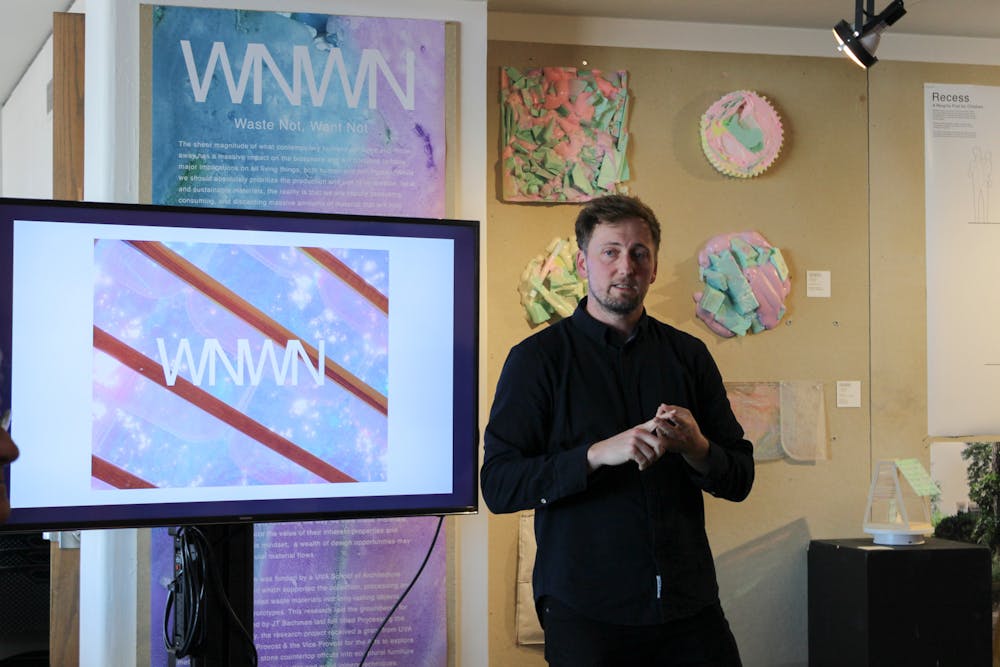While some look at a junkyard and see heaps of plastic, broken materials and tattered cloth, the researchers behind the “Waste Not, Want Not” project see an opportunity. Aiming to mitigate the environmental impact of scrapped resources, the research team spent the last summer and fall repurposing waste into functional items. They unveiled their projects from the last six months to the public Monday at Campbell Corner Gallery and held a gallery talk Friday to showcase their progress towards a more sustainable man-made environment.
J.T. Bachman, assistant professor of the School of Architecture, leads the ongoing initiative. Supported by a $5,000 grant from the School of Architecture, Bachman and fourth-year Architecture student Liv Orlando began “Waste Not, Want Not” as a research project. The two spent the summer of 2023 repurposing discarded materials into items such as backpacks, jackets and construction media. The duo later expanded to include students from Bachman’s fall seminar, amounting to the sizeable research initiative Bachman heads today.
Bachman explained that he and Orlando embarked on their project with the goal of incorporating more sustainable materials into their architectural work.
“[We’re] trying to fold more facets of sustainability into our research,” Bachman said. “[We’re] digging into the topic and realizing how much waste is generated and how much of it is still really useful.”
Their project addressed larger concerns about environmental pollution across the world. As man-made communities expand, the global volumes of solid waste are expected to increase to two billion tons by 2025. The fact that construction and demolition waste makes up about 30 percent of this total solid waste has prompted many architecture professionals to seek out eco-friendly building materials.
Bachman and Orlando pursued their sustainability goals ambitiously, investigating ways to repurpose non-recyclable items. They focused their summer research on polystyrene foam, a lightweight material often used by architecture students for model-making. Breakable, porous and difficult to clean, polystyrene foam is nearly impossible to recycle. However, according to Bachman, Orlando was open to the challenge.
“They brought a willingness to try whatever, and not be worried to do something [and] have it just totally be a complete failure. We brainstorm a bunch of really crazy ideas like this. And they're never afraid to jump into it and try,” Bachman said.
The summer project ushered in Bachman’s “Waste Not, Want Not” fall research seminar, which was offered to undergraduate and graduate students. In a continuation of Bachman and Orlando’s work, students learned how to source scraps from local businesses, rescuing materials that would otherwise end up in a landfill.
In Bachman’s class, graduate Architecture student Emily Ploppert transformed broken stone edges into workable construction forms. For her, working with the stone scraps fueled a budding interest in architectural sustainability.
“As architects, we're leaders in the field and also huge contributors to this massive waste issue in the environment,” Ploppert said. “So how we can reframe our thinking, in terms of addressing this issue, is definitely something that intrigued me.”
According to Ploppert, the projects in Bachman’s class hold both aesthetic and practical value.
“We're incorporating the waste back into the material, but also kind of creating this new beautiful form that gives us this really workable material,” Ploppert said.
Bachman’s hands-on teaching style appeals to many students. According to fourth-year Architecture student Tabi Summers, interactive experiences like the “Waste Not, Want Not” seminar make up the cornerstone of education in the School of Architecture.
“You just can't learn the same when it's not experiential,” Summers said. “I really feel like there's a value to my work or the [research] that I'm assisting with in advancing the profession.”
Together, the “Waste Not, Want Not” summer project and fall course have made a large impact on the Charlottesville area. The initiative has commissioned projects such as a mediation hut for a playground at a local Montessori school, a structure which features movable latches with shingles made from PPE plastic — scrapped COVID-19 masks originally made in the University’s Fabrication Lab.
Observing Friday’s “Waste Not, Want Not” gallery talk, Martha Donnelly, Class of 1975 Architecture alumna and current landscape architect, expressed enthusiasm for the next generation of architecture students.
“I think this is exactly where we, as a culture, need to go. Both at the University, most imperatively, but also as a larger environment,” Donnelly said.
Bachman also conveyed his hope for the project. For him, the chief goal of “Waste Not, Want Not” is to motivate future students to create a sustainably built environment.
“[There’s magic] in what you can do with something that's just been thrown away,” said Bachman. “It's hopefully inspiring [the students] to take it seriously under design as they move forward careers or to go further in education.”
The “Waste Not, Want Not” exhibition is free and open to the public in Campbell Corner Gallery until its closing date, Feb. 26.







